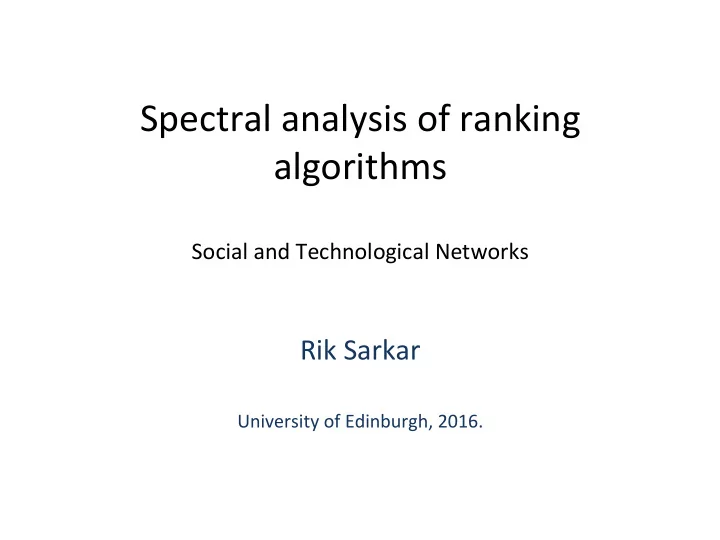

Spectral analysis of ranking algorithms Social and Technological Networks Rik Sarkar University of Edinburgh, 2016.
Recap: HITS algorithm • Evaluate hub and authority scores • Apply Authority update to all nodes: – auth(p) = sum of all hub(q) where q -> p is a link • Apply Hub update to all nodes: – hub(p) = sum of all auth(r) where p->r is a link • Repeat for k rounds
Adjacency matrix • Example
Hubs and authority scores • Can be wriQen as vectors h and a • The dimension (number of elements) of the vectors are n
Update rules • Are matrix mulRplicaRons
• Hub rule for i : sum of a-values of n odes that i points to: • Authority rule for i : sum of h-values of nodes that point to i:
IteraRons • ASer one round: • Over k rounds:
Convergence • Remember that h keeps increasing • We want to show that the normalized value • Converges to a vector of finite real numbers as k goes to infinity • If convergence happens, then there is a c :
Eigen values and vectors • Implies that for matrix • c is an eigen value, with • as the corresponding eigen vector
Proof of convergence to eigen vectors • Useful Theorem: A symmetric matrix has orthogonal eigen vectors. (see sample problems from lecture 1) – They form a basis of n-D space – Any vector can be wriQen as a linear combinaRon • is symmetric
Now to prove convergence: • Suppose sorted eigen values are: • Corresponding eigen vectors are: • We can write any vector x as • So:
• ASer k iteraRons: • For hubs: • So: • If , only the first term remains. • So, converges to
ProperRes • The vector q 1 z 1 is a simple mulRple of z 1 – A vector essenRally similar to the first eigen vector – Therefore independent of starRng values of h • q1 can be shown to be non-zero always, so the scores are not zero • Authority score analysis is analogous
Pagerank Update rule as a matrix derived from adjacency • w
• Scaled pagerank: • Over k iteraRons: • Pagerank does not need normalizaRon. • We are looking for an eigen vector with eigen value=1
• For matrix P with all posiRve values, Perron’s theorem says: – A unique posiRve real valued largest eigen value c exists – Corresponding eigen vector y is unique and has posiRve real coordinates – If c=1, then converges to y
Random walks • A random walker is moving along random directed edges • Suppose vector b shows the probabiliRes of walker currently being at different nodes • Then vector gives the probabiliRes for the next step
Random walks • Thus, pagerank values of nodes aSer k iteraRons is equivalent to: – The probabiliRes of the walker being at the nodes aSer k steps • The final values given by the eigen vector are the steady state probabiliRes – Note that these depend only on the network and are independent of the starRng points
History of web search • YAHOO: A directory (hierarchic list) of websites – Jerry Yang, David Filo, Stanford 1995 • 1998: AuthoritaRve sources in hyperlinked environment (HITS), symposium on discrete algorithms – Jon Kleinberg, Cornell • 1998: Pagerank citaRon ranking: Bringing order to the web – Larry Page, Sergey Brin, Rajeev Motwani, Terry Winograd, Stanford techreport
Spectral graph theory • Undirected graphs • Diffusion operator – Describes diffusion of stuff — step by step – Stuff at a vertex uniformly distributed to neighbors — in every step
Recommend
More recommend